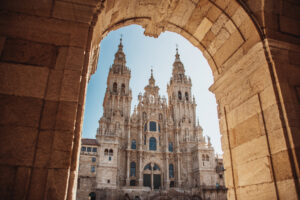
Pilgrimage churches are rich historical markers for saints and events throughout Christendom’s existence. They’re fun and significant places to visit regardless of whether you’re a non-Christian tourist, a history buff, or a Christian of any denomination.
Although anyone –particularly a Protestant– can enjoy visiting the All Saints’ Church in Wittenberg where Martin Luther is said to have affixed his Ninety-five Theses to the door, pilgrimage churches are usually associated with an affiliated saint and are therefore generally in the domain of Catholic and Orthodox branches of Christianity, with a heavy presence in Europe.
And while pilgrimage churches are often the locations of an historic event or the resting place of a particular saint, they’re often located along a pilgrimage route that links these significant churches together in a journey that the faithful can undertake over the course of many days, weeks, or months as part of a physical and spiritual challenge.
Explore a Christian Ministry Degree – Request More Info Today!
Christian Pilgrimages from the Past to Present
War, seemingly mysterious diseases, and oppressive monarchical rule characterized Europe from the advent of Christianity up until the very recent past.
The average person lived in a tumultuous world at the mercy of many forces beyond their control. The best explanation they had of their lot was often one that explained the world in terms of good and evil; sinners and the redeemed; Christians and condemned pagans.
In such an environment, going on a religious journey with the potential benefit of good luck in prospects and health could sound quite appealing, all things considered. As such, understanding the world through the lens of early Christianity naturally involved re-tracing the steps of Jesus and the saints. After all, Abraham dropped everything and left his homeland to follow God, and God ensured things turn out fortunate for him.
How the Final Resting Place of Saint James Became a Destination for Generations of Christians
 A quintessential example of a pilgrimage church is the Cathedral of Santiago de Compostela, the purported final resting place of Saint James, one of Jesus’ original 12 apostles.
A quintessential example of a pilgrimage church is the Cathedral of Santiago de Compostela, the purported final resting place of Saint James, one of Jesus’ original 12 apostles.
Known to many as the Camino de Santiago, the Way of Saint James was not only one of the most important pilgrimage routes of the later Middle Ages –with its popularity being reinvigorated starting in the mid-20th century– today every year hundreds of thousands of pilgrims traverse at least part of this road in a thousands-of-years old Christian pilgrimage tradition.
In Christianity the first pilgrimages were made to the Holy Land, particularly Jerusalem. The tales told by pilgrims undoubtedly had an influence in stirring up motivation for the Crusades, and during this period an entire religious-warrior class emerged dedicated to making a pilgrimage to the Holy Land safe and possible.
This particularly included the pilgrimage route to the Church of the Holy Sepulchre, purported to be the place where Jesus was crucified and the site where he was entombed and then resurrected in Jerusalem.
But even after the Crusades pilgrimages remained popular. They were a way for the common person to travel throughout Europe, and as a bonus they might be cured from disease or granted prosperity.
By some estimates, between the 11th and 16th centuries in Europe more than 20 percent of the population was involved in pilgrimages. The great English work, The Canterbury Tales by Chaucer, was written towards the end of the 14th century and details the exploits of a group of pilgrims along their journey to Canterbury Cathedral to pay homage to the martyr Saint Thomas of Canterbury.
While today the understanding of the world has changed, pilgrimages to churches are as popular as ever. In Europe alone there are dozens of pilgrimage routes, stopping at pilgrimage churches all along the way, crisscrossing the continent from the UK to France to Germany to Italy to Spain, Turkey, Poland and much more.
Five Popular Pilgrimage Churches and Routes
In addition to the Cathedral of Santiago de Compostela and the Church of the Holy Sepulchre, these are some of the most popular pilgrimage churches and accompanying pilgrimage routes:
Sanctuary of Our Lady of Fátima – This Portuguese site contains several highly sacred destinations including the Basilica of Our Lady of the Rosary and the Chapel of the Lausperene. This site is known for the reported appearances of Mary in 1917, as initially witnessed by three shepherd children. Today millions of pilgrims visit the site annually, and there’s a pilgrimage route established between Fatima and Lourdes in France.
Sanctuary of Our Lady of Lourdes – After sanctifying themselves with holy water from this grotto-and-spring site where Mary is reported to have appeared to three children in the 19th century, pilgrims report alleviation from their sicknesses. Every year hundreds of thousands of pilgrims bathe in the holy water from Lourdes. Pilgrims can traverse a route that leads from Lourdes in Southern France through Loyola in Spain to Salamanca, Fatima in Portugal, and finally Lisbon.
Kyiv Pechersk Lavra – Located in the Ukrainian capital Kyiv, this cave monastery was founded in 1051 shortly before the Great Schism that separated the Eastern Orthodox and Roman Catholic faiths. It was here that the religious framework for the cultural peoples known as the Kievan Rus’ was laid, the predecessors of today’s ethno-cultural Ukrainians, Russians, and Belorussians. Saint Anthony of Kyiv and Saint Theodosius of Kyiv are credited as being the founders of this site. Locally within Kyiv there’s a pilgrimage route between these caves and the Saint Sophia Cathedral.
Our Lady of Medjugorje – Named after the city in Bosnia and Herzegovina where Mary is reported to have appeared to six teenagers in 1981, this location as a pilgrimage site has been controversial in the Catholic Church. It was only in 2019 that the pope officially allowed pilgrimages to this site. Today there are various pilgrimage routes to Medjugorje that include passages through Lourdes and Fatima.
Temple of Saint Sava – The founder of Serbian law, a skilled diplomat, and the founder of the Serbian Orthodox Church, the monk Saint Sava (~1169-1236) studied on the sacred Greek island of Athos and is today honored in Belgrade at the Church of Saint Sava. A pilgrim himself who traveled to Palestine, the Holy Land, Greece, Egypt, Turkey, Syria, Armenia, and Bulgaria, Saint Sava is held in high regard by Eastern Orthodox branches with his own dedicated holy day celebrated every year in January. His church is included along any pilgrimage route that passes overland through the Balkans between Europe and the Holy Land.








